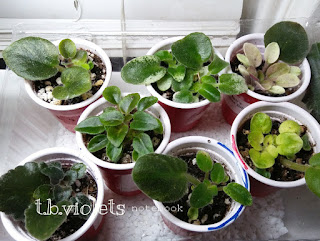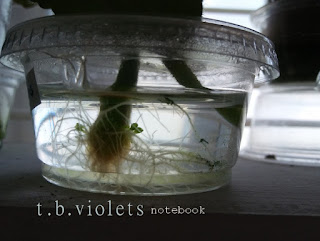Basics for Beginners
Let me start by saying that this can be the least expensive hobby you've ever had - or one of the most expensive. It's your call. You can be happy just growing a few violets in a bright window, maybe pick off a few leaves to start some new babies - happy, happy - or you can put up shelves and lighting on every inch of bare wall & window space you have and spend tons of money on algaecides, mitacides, fungicides, sprays, pots, lights, shelves, plants, etc... until you are near broke feeding your violet habit. If you have a spare room or a basement, you could even have a "plant room". Most violet lovers find a happy medium somewhere in-between.
I like to start off slow and I try to keep myself on a budget... but as with every addiction, that doesn't always work out. I get the biggest kick not out of buying violets (although I like that too), but by propagating them and I get so excited when I see those little baby leaves come up! That's my thing... and I like to blog/write about what I've learned along the way. That's my form of communication. I don't belong to any club because there is no AV club in my city and only one in my state is about 150 miles away. I don't even know any other violet people except on social media. I know there must be violet growers in my area because I see them on violet delivery day at Lowes just browsing around the violets.
But I have learned that there are things you must have if you want to have healthy violets free of pests and be able to keep them going for a long time.
The Basics:
1) You must have good peat growing medium to grow violets in with at least 1/3 to 1/2 perlite - possibly some vermiculite mixed in. Find your own mix and stick with it if it works for you.
2) You must have good light. East or filtered South windows work best. Violets like bright but not direct sun. You can use artificial lighting if you don't have a good window.
3) You must have good water at room temperature or slightly warmer. Filtered, bottled spring water and rain water are good. Softened and hard water are bad. Let the top of the soil dry out before watering. They do not like to be continuously wet. They do not like cold water and they do not like cold temperatures. 65 - 75 F is best but never below 55 F. The roots need to breathe so they don't drown or rot. Over watering is the number one cause of death for violets.
4) You must fertilize to feed your violets if you want healthy leaves and vibrant colors. You can feed a mild solution with every feeding for convenience.
5) Violets need air to be healthy. Not directly blowing on them or from a draft, but circulating air in the room at a comfortable temperature is beneficial to them. Humidifiers and damp gravel trays underneath them in the winter can be used to combat dry air. Violets need to breathe and they need humidity.
6) Violets like to be groomed. You need to pick off the spent or fading blooms if you want it to keep blooming. You need to occasionally brush, wash and clean up your violet leaves. Dead plant material attracts pests. Sometimes you may want to remove the outer ring of leaves to keep the plant smaller or more manageable and to encourage flower growth. You should also re-pot them when needed (get bigger, bad soil, tight leaves etc...)
7) You must have pest, fungus and mold control. If you have violets, sooner or later you will have pests. Use a systemic preventative in the soil that contains Imidacloprid. You can also use something stronger if you see a pest. I use a spray with permethrin or pyrethrin into the damp soil. If you spray a strong bug killer directly on your flowers or leaves you could pit or damage the plant tissues.
Some bugs cannot be seen with the naked eye so it might be helpful if you have an inexpensive 60x jewelers magnifying lens to check your plants on a microscopic level and identify bugs so you'll know what treatment to use when needed. And it feels good when you don't find any bugs on them!
With fungus you may want to brush sulfur on them with a soft brush or spray with a 3-in-1 fungicide with neem oil. Neem oil sprays will not damage the flowers and leaves. You can also mix diatomaceous earth into the soil when potting. It will kill and deter an pest with an exoskeleton in the soil by desiccating it. It works wet or dry.
Growing violets is a learn as you go with the basics applying to everyone. As with any hobby, you can keep it as simple or get as obsessed as you want with it.
So go forth and propagate and happy violeting (is that a word?) !!! It is now.
I like to start off slow and I try to keep myself on a budget... but as with every addiction, that doesn't always work out. I get the biggest kick not out of buying violets (although I like that too), but by propagating them and I get so excited when I see those little baby leaves come up! That's my thing... and I like to blog/write about what I've learned along the way. That's my form of communication. I don't belong to any club because there is no AV club in my city and only one in my state is about 150 miles away. I don't even know any other violet people except on social media. I know there must be violet growers in my area because I see them on violet delivery day at Lowes just browsing around the violets.
But I have learned that there are things you must have if you want to have healthy violets free of pests and be able to keep them going for a long time.
The Basics:
1) You must have good peat growing medium to grow violets in with at least 1/3 to 1/2 perlite - possibly some vermiculite mixed in. Find your own mix and stick with it if it works for you.
2) You must have good light. East or filtered South windows work best. Violets like bright but not direct sun. You can use artificial lighting if you don't have a good window.
3) You must have good water at room temperature or slightly warmer. Filtered, bottled spring water and rain water are good. Softened and hard water are bad. Let the top of the soil dry out before watering. They do not like to be continuously wet. They do not like cold water and they do not like cold temperatures. 65 - 75 F is best but never below 55 F. The roots need to breathe so they don't drown or rot. Over watering is the number one cause of death for violets.
4) You must fertilize to feed your violets if you want healthy leaves and vibrant colors. You can feed a mild solution with every feeding for convenience.
5) Violets need air to be healthy. Not directly blowing on them or from a draft, but circulating air in the room at a comfortable temperature is beneficial to them. Humidifiers and damp gravel trays underneath them in the winter can be used to combat dry air. Violets need to breathe and they need humidity.
6) Violets like to be groomed. You need to pick off the spent or fading blooms if you want it to keep blooming. You need to occasionally brush, wash and clean up your violet leaves. Dead plant material attracts pests. Sometimes you may want to remove the outer ring of leaves to keep the plant smaller or more manageable and to encourage flower growth. You should also re-pot them when needed (get bigger, bad soil, tight leaves etc...)
7) You must have pest, fungus and mold control. If you have violets, sooner or later you will have pests. Use a systemic preventative in the soil that contains Imidacloprid. You can also use something stronger if you see a pest. I use a spray with permethrin or pyrethrin into the damp soil. If you spray a strong bug killer directly on your flowers or leaves you could pit or damage the plant tissues.
Some bugs cannot be seen with the naked eye so it might be helpful if you have an inexpensive 60x jewelers magnifying lens to check your plants on a microscopic level and identify bugs so you'll know what treatment to use when needed. And it feels good when you don't find any bugs on them!
With fungus you may want to brush sulfur on them with a soft brush or spray with a 3-in-1 fungicide with neem oil. Neem oil sprays will not damage the flowers and leaves. You can also mix diatomaceous earth into the soil when potting. It will kill and deter an pest with an exoskeleton in the soil by desiccating it. It works wet or dry.
Growing violets is a learn as you go with the basics applying to everyone. As with any hobby, you can keep it as simple or get as obsessed as you want with it.
So go forth and propagate and happy violeting (is that a word?) !!! It is now.




Comments
Post a Comment